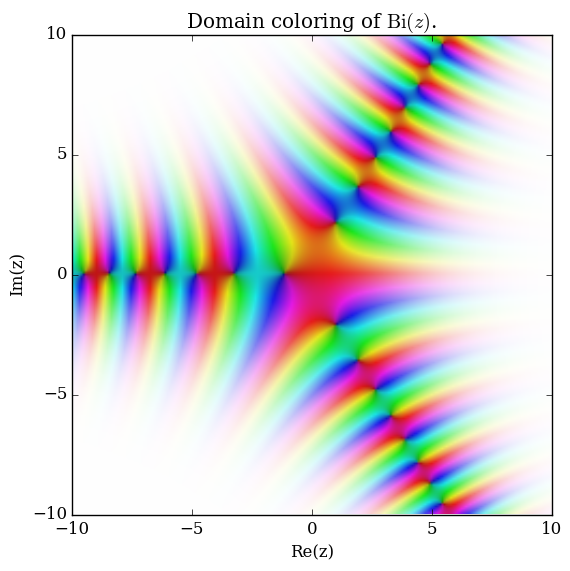Difference between revisions of "Airy Bi"
From specialfunctionswiki
| (41 intermediate revisions by the same user not shown) | |||
| Line 1: | Line 1: | ||
| − | + | __NOTOC__ | |
| − | |||
| − | |||
| − | |||
| − | [[ | + | The Airy function $\mathrm{Bi}$ (sometimes called the "Bairy function") is a solution of the [[Airy differential equation]] |
| + | $$y' '(z)-zy(z)=0,$$ | ||
| + | which is [[linearly independent]] from the [[Airy Ai]] function. | ||
| − | + | <div align="center"> | |
| + | <gallery> | ||
| + | File:Airybiplot.png|Aairy $\mathrm{Bi}$ function. | ||
| + | File:Complexairybiplot.png|[[Domain coloring]] of $\mathrm{Bi}$. | ||
| + | </gallery> | ||
| + | </div> | ||
=Properties= | =Properties= | ||
| − | < | + | [[Relationship between Airy Bi and modified Bessel I]]<br /> |
| − | + | [[Relationship between Scorer Gi and Airy functions]]<br /> | |
| − | + | [[Relationship between Scorer Hi and Airy functions]]<br /> | |
| − | < | ||
| − | |||
| − | |||
| − | |||
| − | |||
| − | |||
| − | |||
| − | |||
| − | |||
| − | |||
| − | |||
| − | |||
| − | |||
| − | |||
| − | |||
| − | |||
| − | |||
| − | |||
| − | |||
| − | |||
| − | |||
| − | |||
| − | |||
| − | |||
| − | + | =Videos= | |
| − | + | [https://www.youtube.com/watch?v=HlX62TkR6gc&noredirect=1 Leading Tsunami wave reaching the shore (27 November 2009)]<br /> | |
| − | + | [https://www.youtube.com/watch?v=0jnXdXfIbKk&noredirect=1 Series solution of ode: Airy's equation (3 November 2010)]<br /> | |
| − | + | [https://www.youtube.com/watch?v=oYJq3mhg5yE&noredirect=1 Airy differential equation (26 November 2013)]<br /> | |
| − | |||
| − | |||
| − | |||
| − | </ | ||
| − | </ | ||
=References= | =References= | ||
| + | [http://www.ams.org/samplings/feature-column/fcarc-rainbows The mathematics of rainbows]<br /> | ||
| + | [http://www.ams.org/journals/mcom/1979-33-145/S0025-5718-1979-0514831-8/S0025-5718-1979-0514831-8.pdf Tables of Weyl Fractional Integrals for the Airy Function]<br /> | ||
| + | [http://www.amazon.com/Special-Functions-Introduction-Classical-Mathematical/dp/0471113131 Special Functions: An Introduction to the Classical Functions of Mathematical Physics]<br /> | ||
| + | [http://www.people.fas.harvard.edu/~sfinch/csolve/ai.pdf Airy function zeros] | ||
| + | |||
| + | =See Also= | ||
| + | [[Airy Ai]] <br /> | ||
| + | [[Scorer Gi]] <br /> | ||
| + | [[Scorer Hi]] <br /> | ||
| + | |||
| + | [[Category:SpecialFunction]] | ||
Latest revision as of 16:07, 21 October 2017
The Airy function $\mathrm{Bi}$ (sometimes called the "Bairy function") is a solution of the Airy differential equation
$$y' '(z)-zy(z)=0,$$
which is linearly independent from the Airy Ai function.
Domain coloring of $\mathrm{Bi}$.
Properties
Relationship between Airy Bi and modified Bessel I
Relationship between Scorer Gi and Airy functions
Relationship between Scorer Hi and Airy functions
Videos
Leading Tsunami wave reaching the shore (27 November 2009)
Series solution of ode: Airy's equation (3 November 2010)
Airy differential equation (26 November 2013)
References
The mathematics of rainbows
Tables of Weyl Fractional Integrals for the Airy Function
Special Functions: An Introduction to the Classical Functions of Mathematical Physics
Airy function zeros

